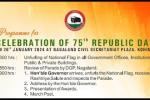

MIMKUT AND CHAVANG KUT - KUKI TRIBE
Mimkutis the harvest festival of the Kukis. Kukis of Nagaland celebrate this festival on the 17th Kuki month of Tolbol (January) every year. The celebration lasts one week. Besides Mimkut, Kukis celebrate Chapphou Kut and Chavang Kut as wellas other smaller festivals.
It is believed that Mimkut and other festivals came into being from the fact that, in order to appease Thilha (Demon). The people offered sacrifices and at the same time they also believed in the existence of a Supreme God whom they called"Chung Pathen" (Heavenly God). To get the blessings of such gods, the village Medicine man (Thempu)would sacrifice fowls to propitiate the spirit of the Demon-god by performing a series of rituals and prayer.
Tradition handed down orally from generation to generation says that the Kukis originated from subterranean underworld. They came out from this underworld in search of better land. They brought with them a number of cereals such as millet,tapioca, beans, yam etc. After they came over ground they found paddy and job's tears together, which were brought across a river called Twinanhem by a pair of wild rats on a bamboo sheath(Stipule) tucked in their mouths. Gradually they found Mithun from a place called Sisep, Pig from Bonnol and Fowl from Molkon which they domesticated. They would lavishly use these animals during such festivals. Thus the cultivation of Job’s tears started. They found that' it wasmore productive and yielded a better harvest.
The celebration of the completion of the year's harvest is done with the instruction and guidance of the village Medicine man(Thempu). On that day, for the entire village, the Medicine man would chant incantations to the God for the rich harvest and invoke the spirit for more abundant harvests in the coming years. The Mimkut is essentially a wrap-up of the year-long toils of the land.The celebration is marked by feasting and drinking of Madhu (rice-beer). The youths engage themselves in various types of merry making, and fetching of water and firewood. Traditional sports like wrestling and other games and different kinds of amusements continue throughout the day and night. The older people sit by the fire-side singing traditional song sand the more enthusiastic ones dance and crack jokes from time to time.
A simple translation of one of the songs sung during the celebration of Mimkut is as follows:
"Job'stear is harvested and gathered.
Timeto wrap up the year's toil and relax;
Countless birds encircle the Job’s tears field.
Suddenly one kite swoops down and away it carries off one;
Before a stone could be pelted at it".
Sequence of Seven Days Mimkut Celebrations:
The First Day of Mimkut is exclusive for the Village Priest-Shaman. He would perform a series of rituals asking the god Thilha (demon) about the good or bad time for the celebration. Accordingly, he would announce the date and manner of celebration. The announcement is done early in the morning at cock-crow with the accompaniment of the sound of Gong and Drum. Everyone then starts the preparations mentally and physically.
On the Second Day early in the morning, the Village Shaman would perform rites and rituals at the Village Water Point and at other ominous places like biggest tree and biggest rock near the Village, believed to be the abode of god Thilha(demon), by sacrificing an unblemished white fowl.
The Third Day is devoted to cleaning of the village, footpath to Water Point,Khetis and neighboring Villages. The womenfolk prepare food, Ju and other drinks. They would serve them to the menfolk who are working.
On the Fourth Day, able-bodied men from each household and the youth from Phan(Dormitory) would go to the jungle to rope a Mithun. The Mithun is brought to the Village and tied to a post having three branches. No ordinary tree or post is used. On this day the womenfolk and youngsters bring millet, yam, pumpkin,job's tears and other kheti produces. They prepare country-baked cake and cook yam, pumpkin, tapioca etc. These a reserved to the men folk on arrival with the Mithun. The boys and girls fetch firewood, water and leaves required for the feast.
On the Fifth Day, the Mithun is ceremoniously killed after observing rites by the Shaman. The men folk cut and prepare the Mithun. The womenfolk continuously serve Madhu and other drinks. The boys and girls, wearing the best of clothe sand other garments, sing and dance throughout the day. The whole day is devoted to merrymaking, jest, singing and dancing. New songs are taught and learned.The whole evening is spent in feasting and revelry. The main Kut Feast is enjoyed together by one and all.
The Sixth Day is devoted to sports. Different age groups are formed and competition goes on throughout the day. The elder group, the younger group and the women group would vie for the coveted prize which is normally a lump of Mithun meat set aside. The Sports competed are mostly shot-put, race, pole climbing,wrestling, mithun jump, pole throw (pole used for pounding rice) etc. Other traditional games are also played. The women section also competes in various types of sports, whereas the aged and children would enjoy watching. The night is a get together night. A big camp-fire is lit and folk songs and folk dances,punctuated by jokes continue throughout the night.
The Seventh Day - the last day, is the coming together of mainly family members and neighbors. Married daughters with husband and children would visit their parents, brothers and sisters and exchange gifts. They will be reciprocated and sent back after being entertained.
The Shaman would announce the closing of the celebration after performing rites and rituals in the same manner by again releasing a spotless white fowl to please Thilha god (demon). And with a good omen for the village (prosperity and health), he would announce the closure of the celebration officially.
The village will then begin the year’s activity.






